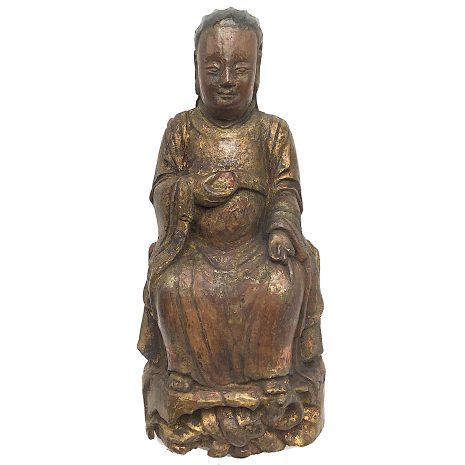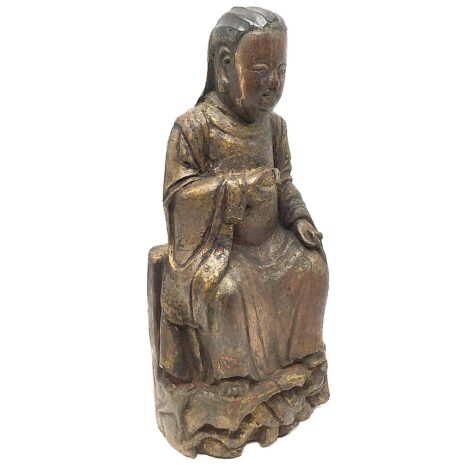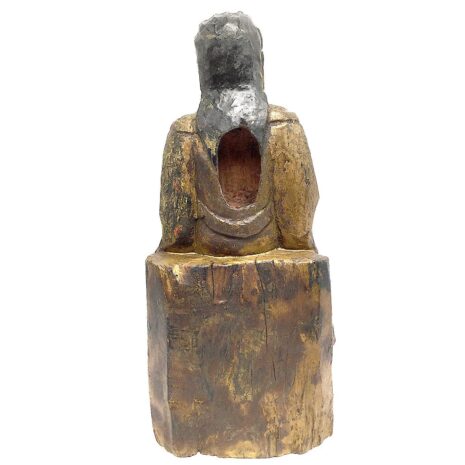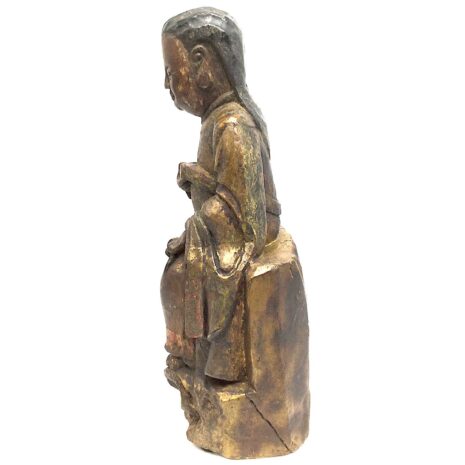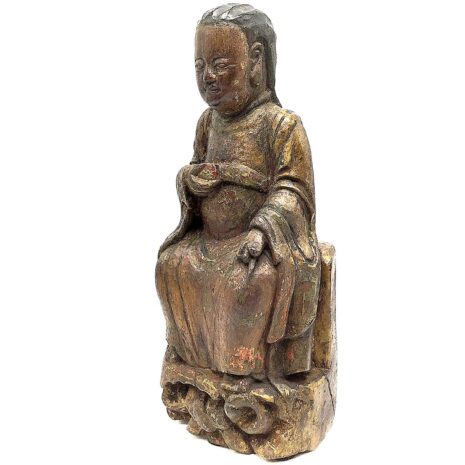SOLD Antique Zhenwu, The Taoist “Perfected Warrior,” China (16097)
Original price was: $595.00.$395.00Current price is: $395.00.
H: 12″ W:5.6 ” D:4″ | FREE SHIPPING WITHIN CONTINENTAL U.S.!
Zhenwu, the True Warrior, Perfected Warrior or Northern Emperor was one of the most popular TaoistDeities in the Ming and Qing dynasties known as protector of the state and the imperial family. His feet here rest on a pedestal over a turtle with a lifted head and a snake curled around his shell. Among the many interpretations this represent beings over whom he presided including both celestial officers under his command, [and] former demons that were conquered by him. This is a fascinating carving symbolizes trusted strength. and power.
Out of stock
Description
Zhenwu was known by many names and titles, the most common ones being the True Warrior, Perfected Warrior or Northern Emperor. As one of the most popular TaoistDeities during the Ming and Qing dynasties he was an emperor known as protector of the state and the imperial family. During the imperial dynasties was a patron god of soldiers and a protector of national security. Depicted in all sizes, larger imperially sanctioned ones were displayed in temples and large clan shrines made of porcelains and bronze. Small ones like this antique-Chinese-wood-carving were made for personal worship and crafted by provincial artisans who improvised on his form, attributes and iconography and depicted him as a modest folk-art figure. The gilt covering the entire carving reflects his regal status and perhaps is an attempt to make it appear more like a bronze status. Carved from dense hardwood the image is depicted in officials-attire rather than his traditional military garb. His right hand holds his official’s belt and his left is in a variation of karana mudra (“anger fist”) for casting out demons and warding off negative spirits/energy which is appropriate as he is believed to have used his magical powers to destroy or ward off the “the hordes of malevolent and evil spirits roaming the earth from the Underworld (who) can only be held in check or destroyed by the Northern Emperor’s large force of spirit soldiers.”(Stevens. p. 19) His most iconic references are the mythical animals with which he is associated: the tortoise and the snake. His feet rest on a pedestal under which is a turtle, his head lifted to the right, with a snake curled around his shell. There are many interpretations about their symbolism, some claim they represent beings over whom he presided including “…both celestial officers under his command, [and] former demons that were conquered by him.” (Stevens, p.19.) In Taoist beliefs, the tortoise symbolizes heaven and earth: the shell is the vaulted heaven and its underside is the flat disc of the earth. The tortoise also signifies longevity, immutability, and steadfastness. Greve claims the ancients believed there were no male tortoises so the females had to mate with a snake, and “…the tortoise embracing a snake became the protector symbol of the north; but as the word ‘tortoise’ was taboo in Chinese, it was referred to as the “dark warrior” and finally became “… one of the protector gods of the four areas, Zhenwu.” He is a Chinese syncretic god, still venerated today by Taoist, Buddhist and Popular Religion devotees. He is in very good condition with much of the original gilt and red lacquer remaining that has naturally darkened over time and has expected age cracks. The rear cavity, surrounded by the black hair flowing down his back indicates the carving was consecrated and was probably placed on a home altar.
Click here for the Blog Consecrating Wooden Images to Imbue Them with A Life Force
Sources
Gabi Greve, Daruma Museum, Tortoise and Snake,
Jeremy Roberts, Chinese Mythology A to Z, New York, Facts on File, 2004.
Dale Saunders, Mudra: A Study of Symbolic Gestures in Japanese Buddhist Sculpture, Princeton, Princeton University Press, 1960
Brock Silvers, The Taoist Manual: An Illustrated Guide, Applying Taoism to Daily Life, Honolulu, Sacred Mountain Press, 2005.
Keith G. Stevens, Images of Asia Chinese Mythological Gods, Oxford University Press, New York, 2001.
The Art Institute of Chicago, Taoism and the Arts of China: The Taoist Renaissance, 2000.
Additional information
| Place of Origin | China |
|---|---|
| Period | Antique, Qing Dynasty |
| Date | Late 18th – Early 19th Century |
| Materials and Technique | Wood |
| Dimensions (inches) | Ht: 12” W: 5.625” D: 4.” |
| Dimensions (metric) | Ht: 30.48cm W: 14.285cm D: 10.79cm |
| Weight | 2 lbs 15 oz |
| Condition | Very good, patina and wear consistent with age and use |
| Item Number | 16097BME |
| Shipping Box Size |

